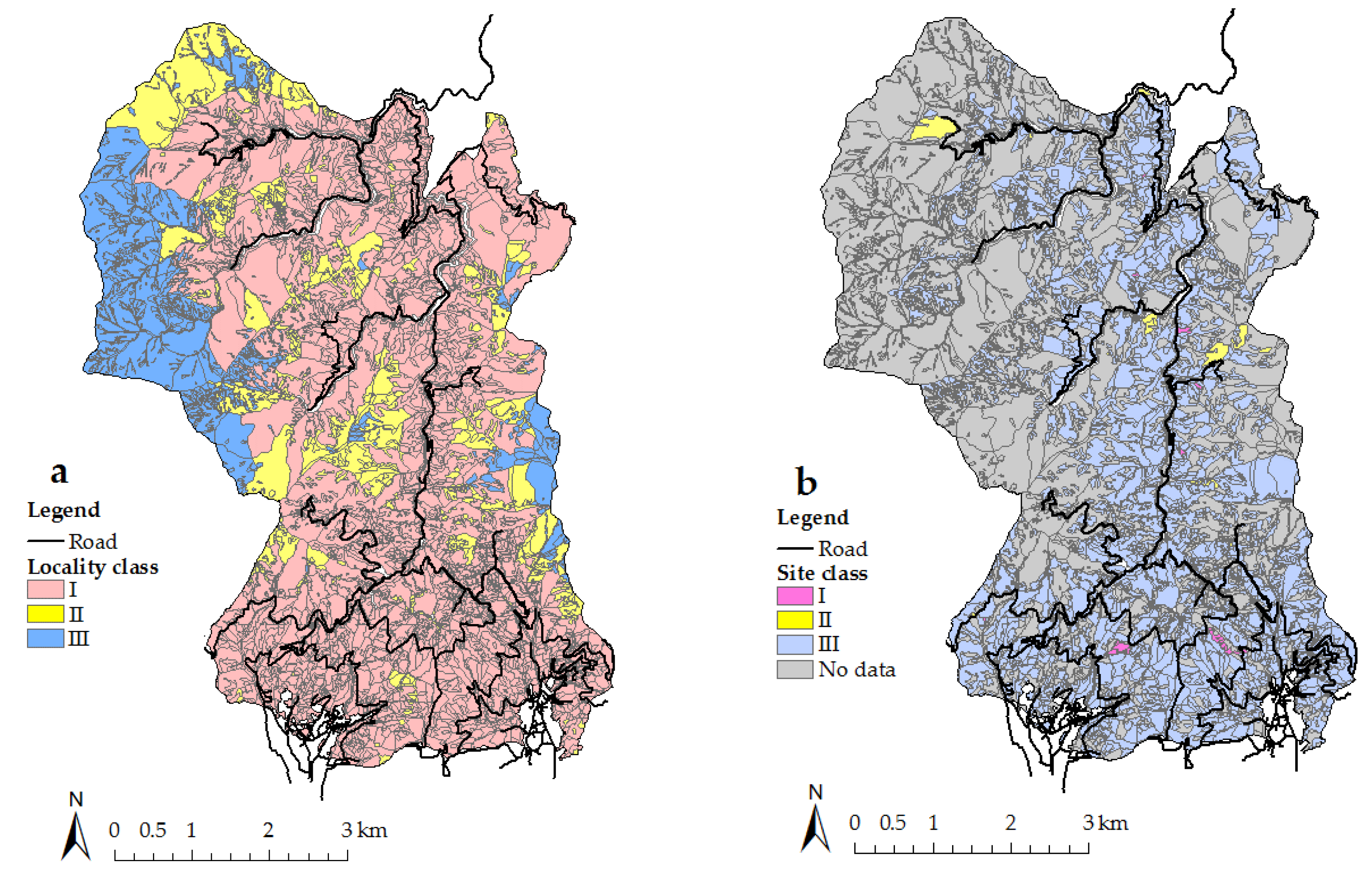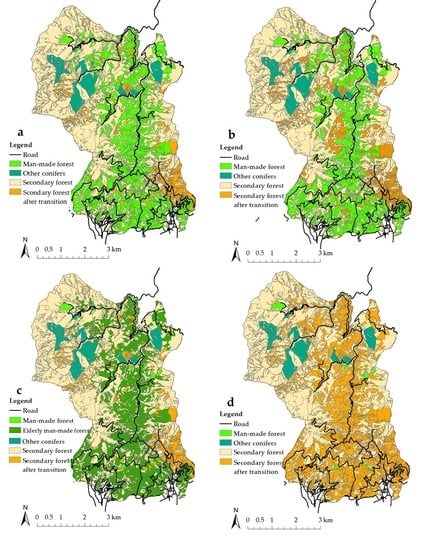Application of an Adaptive Forest Management Simulation Model Based on Zoning in a Man-Made Forest
Abstract
:1. Introduction
2. Materials and Methods
2.1. Study Area
2.2. A Simulation Model Based on Zoning in a Man-Made Forest
3. Results
3.1. Current Status of the Study Area
3.2. Simulation Results
4. Discussion
5. Conclusions
- Easy simulation possible;
- Prediction of wide-area and medium-to-long term changes in each scenario;
- Geo-visualization of spatial distribution by GIS;
- Effective dissemination of results to local residents.
Author Contributions
Funding
Acknowledgments
Conflicts of Interest
References
- Cerutti, P.O.; Tacconi, L.; Nasi, R.; Lescuyer, G. Legal vs. certified timber: Preliminary impacts of forest certification in Cameroon. For. Policy Econ. 2011, 13, 184–190. [Google Scholar] [CrossRef]
- Hayami, T. Why and how I challenged the first FSC certification in Japan. Jpn. J. For. Plan. 2000, 34, 127–130. (In Japanese) [Google Scholar] [CrossRef]
- Iwamoto, Y.; Shiga, K. Development of SGEC forest certification and response of forestry enterprises. In Framework Formation and Forestry Labor Issues of Regional Forest Management; Shiga, K., Fujikake, I., Koroki, K., Eds.; Japan Forestry Investigation Committee: Tokyo, Japan, 2011; pp. 161–194. ISBN 978-4-88965-205-5. (In Japanese) [Google Scholar]
- Sakamoto, T.; Shiba, M. The effects of forest certification scheme on forest management practice: Case study in the result of SGEC and FSC forest certification assessment in Japan. Appl. For. Sci. 2009, 18, 9–14, (In Japanese with English Abstract). [Google Scholar] [CrossRef]
- Sugiura, K.; Konohira, Y. Features of evaluations of FSC certification bodies: Analysis of certification results of 17 Japanese forests. J. Jpn. For. Soc. 2005, 87, 241–246, (In Japanese with English Summary). [Google Scholar] [CrossRef]
- Sugiura, K.; Yoshioka, T.; Inoue, K. Effects of acquiring FSC forest management certification for Japanese enterprises using SmartWood audits. J. For. Res. 2012, 23, 165–172. [Google Scholar] [CrossRef]
- Sugiura, K.; Sonohara, W. Trends in evaluations of Sustainable Green Ecosystem Council (SGEC) certified forests in Japan. Small-Scale For. 2017, 16, 37–51. [Google Scholar] [CrossRef]
- Sugiura, K.; Yoshioka, T.; Inoue, K. Improvement of forest management in Asia, through assessment of Forest Stewardship Council certification. For. Sci. Technol. 2013, 9, 164–170. [Google Scholar] [CrossRef]
- Sugiura, K.; Oki, Y. Reasons for choosing Forest Stewardship Council (FSC) and Sustainable Green Ecosystem Council (SGEC) schemes and the effects of certification acquisition by forestry enterprises in Japan. Forests 2018, 9, 173. [Google Scholar] [CrossRef]
- Tomimura, S. The Japanese forest and forestry course: Findings from the FSC forest certification. Mizu-Joho 2003, 23, 13–17. (In Japanese) [Google Scholar]
- Nishikawa, K. Introduction to Modern Forest Planning: Forest Management for the 21st Century; Japanese Society of Forest Planning Publishing: Tokyo, Japan, 2004; p. 274. ISBN 4-915870-29-4. (In Japanese)
- Kakizawa, H. Forest planning and society. In Forest Planning; Konohira, K., Ed.; Asakura Publishing Co. Ltd.: Tokyo, Japan, 2003; pp. 40–63, (In Japanese). ISBN 4-254-47034-7. [Google Scholar]
- Konohira, Y. Study on the System Yield Table: Report No.: MEXT KAKENHI Grant Number JP02304022; Ministry of Education of Japan: Tokyo, Japan, 1992; p. 138. (In Japanese)
- Konohira, Y. Study on the Practical Software Development of System, Yield Table: Report No.: MEXT KAKENHI Grant Number JP04556019; Ministry of Education of Japan: Tokyo, Japan, 1995; p. 198. (In Japanese)
- Konohira, Y. Definition of the system yield table. J. For. Plan. 1995, 1, 63–67. [Google Scholar] [CrossRef]
- Matsumoto, M. Construction of yield tables for sugi (Cryptomeria japonica) in Kumamoto district using LYCS. J. For. Plan. 1997, 3, 55–62. [Google Scholar] [CrossRef]
- Matsumoto, M.; Nakajima, T.; Hosoda, K. Improvement of LYCS, a software for construction of local yield tables. J. Jpn. For. Soc. 2011, 93, 187–195, (In Japanese with English Summary). [Google Scholar] [CrossRef]
- Nagahama, T.; Kondoh, H. A formulation of SILKS, a system yield table for sugi (Cryptomeria japonica I D. Don) plantations in Kagoshima Prefecture. Jpn. J. For. Plan. 2006, 40, 221–230, (In Japanese with English Summary). [Google Scholar] [CrossRef]
- Nakajima, T.; Shiraishi, N. Application of the local yield table construction system to a timber self-supply production strategy in Ise Shrine Forest with special focus on the Shikinen Sengu Ceremony. J. Jpn. For. Soc. 2007, 89, 21–25, (In Japanese with English Summary). [Google Scholar] [CrossRef]
- Tatsuhara, S. Predicting growth of coniferous plantations using a stand table data base. Jpn. J. For. Plan. 1995, 24, 25–32, (In Japanese with English Summary). [Google Scholar] [CrossRef]
- Zheng, X.-X. Method of constructing a system yield table. J. Jpn. For. Soc. 1994, 76, 132–137, (In Japanese with English Summary). [Google Scholar] [CrossRef]
- Shiraishi, N. Study on the growth prediction of even-aged stands. Bull. Univ. Tokyo For. 1986, 75, 199–256. Available online: https://repository.dl.itc.u-tokyo.ac.jp/?action=pages_view_main&active_action=repository_view_main_item_detail&item_id=25593&item_no=1&page_id=28&block_id=31 (accessed on 18 May 2018). (In Japanese with English Summary).
- Kato, A.; Tanaka, K.; The growth parameters of the system yield table “Silv-no-mori” in Tateyama-sugi (Cryptomeria japonica D.Don) stands. Bull. Toyama For. Res. Inst. 2009, 44–51. Available online: http://taffrc.pref.toyama.jp/nsgc/shinrin/webfile/t1_31bdc5e3312230446dd394d6f3049bbc.pdf (accessed on 28 May 2018). (In Japanese with English Summary).
- Zhou, X. The forest forecast map based on system yield table: Spatial retrieval and forecast. Jpn. J. For. Plan. 1995, 25, 27–31, (In Japanese with English Summary). [Google Scholar] [CrossRef]
- Nothdurft, A.; Saborowski, J.; Breidenbach, J. Spatial prediction of forest stand variables. Eur. J. For. Res. 2009, 128, 241–251. [Google Scholar] [CrossRef] [Green Version]
- Druckenbrod, D.L.; Shugart, H.H.; Davies, I. Spatial pattern and process in forest stands within the Virginia piedmont. J. Veg. Sci. 2005, 16, 37–48. [Google Scholar] [CrossRef]
- Li, H.; Franklin, J.F.; Swanson, F.J.; Spies, T.A. Developing alternative forest cutting patterns: A simulation approach. Landsc. Ecol. 1993, 8, 63–75. [Google Scholar] [CrossRef]
- Monserud, R.A. Evaluating forest models in a sustainable forest management context. FBMIS 2003, 1, 35–47. Available online: http://citeseerx.ist.psu.edu/viewdoc/download?doi=10.1.1.458.4718&rep=rep1&type=pdf (accessed on 18 May 2018).
- Kimmins, J.P. Modelling the sustainability of forest production and yield for a changing and uncertain future. For. Chron. 1990, 66, 271–280. [Google Scholar] [CrossRef]
- Peuplements forestiers du massif Vosgien. Le Ban Saint-Martin: Centre Régional de la Propriété Forestiére de Lorraine-Alsace (France). Available online: http://www.crpf.fr/new/telechargement%20dossiers/guide_massifvosgien.pdf (accessed on 16 December 2008). (In French)
- Forestry Agency of Japan. Annual Report on Trends in Forest and Forestry in Japan: Fiscal Year 2016; National Forest Development and Extension Association: Tokyo, Japan, 2017; p. 236. ISBN 978-4-88138-349-0. (In Japanese)
- Population and Household of Kanagawa Prefecture. Available online: http://www.pref.kanagawa.jp/docs/x6z/tc30/jinko/jimkotosetai.html (accessed on 27 April 2019).
- Konohira, Y. The working of headwater forest. In Natural Regeneration of Tanzawa; Konohira, Y., Katsuyama, T., Tamura, A., Yamane, M., Hayama, S., Itonaga, K., Hara, K., Tanigawa, K., Eds.; Japan Forestry Investigation Committee: Tokyo, Japan, 2012; pp. 21–26. ISBN 978-4-88965-225-3. (In Japanese) [Google Scholar]
- Inamoto, K. Kanagawa suigen-no shinnrin zukuri (improving forests in the headwater of Kanagawa). In Natural Regeneration of Tanzawa; Konohira, Y., Katsuyama, T., Tamura, A., Yamane, M., Hayama, S., Itonaga, K., Hara, K., Tanigawa, K., Eds.; Japan Forestry Investigation Committee: Tokyo, Japan, 2012; pp. 91–96. ISBN 978-4-88965-225-3. (In Japanese) [Google Scholar]
- Konohira, Y. Preface. In Natural Regeneration of Tanzawa; Konohira, Y., Katsuyama, T., Tamura, A., Yamane, M., Hayama, S., Itonaga, K., Hara, K., Tanigawa, K., Eds.; Japan Forestry Investigation Committee: Tokyo, Japan, 2012; pp. 19–20. ISBN 978-4-88965-225-3. (In Japanese) [Google Scholar]
- Konohira, Y. History of plantation forest and future management. In Natural Regeneration of Tanzawa; Konohira, Y., Katsuyama, T., Tamura, A., Yamane, M., Hayama, S., Itonaga, K., Hara, K., Tanigawa, K., Eds.; Japan Forestry Investigation Committee: Tokyo, Japan, 2012; pp. 73–83. ISBN 978-4-88965-225-3. (In Japanese) [Google Scholar]
- Ota, T. Mountainous areas as a water source area. In Mountainous Area and Multifaceted Function; Tabuchi, T., Shiomi, M., Eds.; Association of Agriculture & Forestry Statistics: Tokyo, Japan, 2002; pp. 6–29. ISBN 4-541-02883-2 C 3061. (In Japanese) [Google Scholar]
- Ota, T. Multiple functions of Forest and Zoning. Shinrin Kagaku 2005, 43, 11–17. (In Japanese) [Google Scholar] [CrossRef]
- Kanagawa Prefecture. Promotion of Forestry Project for Water Source; Kanagawa Prefecture: Yokohama, Japan, 2017; Available online: http://www.pref.kanagawa.jp/uploaded/attachment/707824.pdf (accessed on 1 March 2017). (In Japanese)
- Masutani, T. On the interest of forestry by site quality and location class. In Results of the Scientific Research on the Tanzawa Mountains; Research Group of the Tanzawa Mountains, Hiraoka Environmental Science Laboratory: Kanagawa, Japan, 2007; pp. 537–540. ISBN 978-4-9903753-0-0. (In Japanese) [Google Scholar]
- Kuroiwa, Y. Prediction of Thinning Volume and Manpower Requirement Based on Forest Management Plan of Environmental Conservation Type. Master’s Thesis, Graduate School of Bioresource Sciences, Nihon University, Kanagawa, Japan, 25 March 2005. (In Japanese). [Google Scholar]











| Plan | Man-Made Forest (Sugi and Hinoki) | Elderly Man-Made Forest | Secondary Forest |
|---|---|---|---|
| Current forest stands | 2322 (1625 ha) | 0 | 2123 (2159 ha) |
| Plan 1 | 1663 (1336 ha) | 0 | 2782 (2448 ha) |
| Plan 2 | 1432 (1152 ha) | 0 | 3013 (2632 ha) |
| Plan 3 | 32 (35 ha) | 1631 (1301 ha) | 2782 (2448 ha) |
| Plan 4 | 32 (35 ha) | 0 | 4413 (3749 ha) |
| Values are the number of forest stands, and bracketed values show the forest areas. | |||
© 2019 by the authors. Licensee MDPI, Basel, Switzerland. This article is an open access article distributed under the terms and conditions of the Creative Commons Attribution (CC BY) license (http://creativecommons.org/licenses/by/4.0/).
Share and Cite
Sugiura, K.; Sonohara, W. Application of an Adaptive Forest Management Simulation Model Based on Zoning in a Man-Made Forest. Forests 2019, 10, 482. https://doi.org/10.3390/f10060482
Sugiura K, Sonohara W. Application of an Adaptive Forest Management Simulation Model Based on Zoning in a Man-Made Forest. Forests. 2019; 10(6):482. https://doi.org/10.3390/f10060482
Chicago/Turabian StyleSugiura, Katsuaki, and Waka Sonohara. 2019. "Application of an Adaptive Forest Management Simulation Model Based on Zoning in a Man-Made Forest" Forests 10, no. 6: 482. https://doi.org/10.3390/f10060482
APA StyleSugiura, K., & Sonohara, W. (2019). Application of an Adaptive Forest Management Simulation Model Based on Zoning in a Man-Made Forest. Forests, 10(6), 482. https://doi.org/10.3390/f10060482






